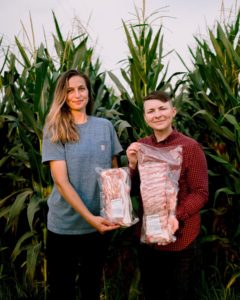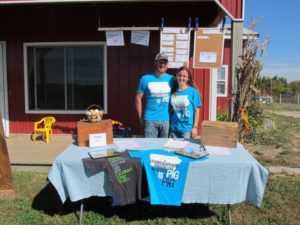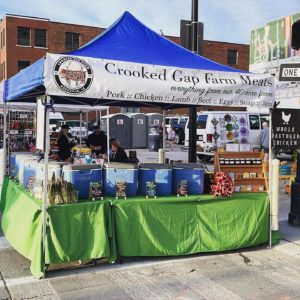Nourishing Community Through Local Meat
Some farmers are finding success connecting with customers and selling meat directly
Directly marketing meat, for some farmers and producers, can be a way to capture more of the consumer dollar. By bypassing the middlemen – wholesalers, distributors and retailers – direct marketing allows meat producers to receive retail value for their product. For the farmers behind Crooked Gap Farm and Over the Moon Farm & Flowers, direct marketing and developing personal connections with customers has been key to getting established in the marketplace.
Finding a Niche, Connecting With Customers
Crooked Gap Farm is owned and operated by Ethan Book, his wife Rebecca and their six children – Caleb, Hannah, Isaac, Jonathan, Josiah and Abigail. Together, they raise pastured and grass-fed heritage breeds of pork, beef, lamb and poultry on 40 acres near Knoxville, Iowa. The family operates a meat CSA, markets whole and half hogs and sells individual meat cuts. These diverse marketing options provide a unique opportunity for customers to try cuts of meat not commonly seen in a grocer’s meat case or frozen foods aisle.
Ethan and Rebecca bought their land and started farming in 2007, but early on, they realized that their farmland was not suitable to sustain a growing herd of grass-fed cattle. “Realistically, we only have about 20 acres of pasture, which is not enough to sustain a viable business based on grass-fed beef,” Ethan says. The Books pivoted to pork, realizing pigs were a more suitable species of livestock to expand on the farm.
In 2009, Ethan purchased his first drove of feeder pigs and processed them into custom cuts, marketing the meat to friends and family. Their first foray into marketing off the farm was at the Living History Farms farmers market in 2010. Starting at a smaller market allowed Ethan and Rebecca to get a feel for how best to market, learn what products sell and solidify the niche they sought to fill. This experience prepared them to become a vendor at the larger Des Moines’ Downtown Farmers’ Market the following year.
“The thing I love most about setting up at the market is the chance to interact with people,” Ethan says. “Not everybody I talk to purchases something, but it gives me the opportunity to share about our farm and the reasons why we farm the way we do.”
Relationship Marketing
Building relationships has been key to establishing Crooked Gap’s direct-marketing business. Beyond solidifying a customer base, Ethan and Rebecca have also forged partnerships with other farmers and chefs. One of those fruitful connections has been with Brett McClavy, executive chef of Cheese Bar, the sister restaurant to the brick-and-mortar Cheese Shop in Des Moines.
The Cheese Shop hosts a pop-up market where farmers and food artisans are able to sell locally sourced goods. It was at the pop-up market that Ethan met Jordan Clasen of Grade A Gardens and initiated a partnership to offer and promote each other’s products. “As folks come to pick up their veggie shares, they will purchase brats or meat cuts from us and vice versa,” Ethan says. “That’s been the secret sauce for us, the connections we have built with others.”
Partnering with other farmers provides an opportunity for both experienced and beginning direct-market meat farmers to continue to grow their customer base while adding value to others’ market offerings.
This has been true for beginning farmers Anna Hankins and Shae Pesek of Over the Moon Farm & Flowers. The couple launched their farm on Shae’s family farm near Coggon, Iowa, in July 2019, starting with an acre of sweet corn, experimenting with their first batch of flowers and raising beef, chickens, pigs and goats. The desire to pursue a rural life and start a farm business drew both women to eastern Iowa – in Shae’s case, back to her family farm in Delaware County. “Shae grew up on a cattle farm and my heart has always been in livestock farming as well,” Anna says. “We knew we wanted to have a direct-to-consumer meat business.”

Anna Hankins (left) and Shae Pesek, of Over the Moon Farm & Flowers, pose with packages of their meat.
During their second season, Anna and Shae collaborated with Local Harvest CSA, run by Maja and Carmen Black near Solon, Iowa, and Buffalo Ridge Orchard, operated by Emma and Marcus Johnson near Central City, Iowa, to offer Over the Moon’s flowers in conjunction with the other two farms’ vegetable shares.
“Collaborating with our farmer friends gave us a great leg up in direct-to-consumer marketing,” Anna says. “Flowers are an awesome cash crop and they have allowed us to start a business without really any capital investment.”
It’s Not a Race to the Bottom
After the success of their flower CSA, Anna and Shae began to envision a similar model for marketing meat. “Raising animals is the fun part and we are so grateful to do it,” Anna says. “The hard part is navigating a way to make sure we move all that meat.” For Shae, raising livestock connects to her experiences growing up on a cattle farm and actively showing livestock and judging meat through 4H and National FFA Organization. “For me, it feels deeply satisfying to be able to provide a product folks really enjoy, and that can nourish their families,” Shae says. “It just brings me a lot of joy to raise livestock.”
At Over the Moon, customers can sign up for a three-month “farmers’ choice” meat share, where customers can get a variety of cuts and meats depending on what Anna and Shae select. This allows for the farm to have a better market flow of meat depending on what is available. Starting the farm with a horticultural crop like flowers and now incorporating meat into their offerings has allowed Anna and Shae to move from seasonal year-round operation.
“Starting with flowers was important for our cash flow. We are going to continue to do flowers, but we also hope to grow our meat enterprise and offer flowers seasonally,” Anna says. “Marketing meat has allowed us to have a year-round business for the first time. It felt so good to have something to sell in January besides CSA shares – but to be able to sell a product is different.”
Making the Grade
For beginning farmers, direct-marketing products can be a challenge. Navigating what products to offer while also learning how to break into a market can be frustrating. Add to that the complexities of being a small- to mid-scale livestock producer and facing the bottlenecks of limited processing options.
As beginners newly launching meat sales, Anna and Shae had difficultly booking locker dates. This led to using different lockers and inconsistent cuts of meat. “We have some real, logistical barriers,” Anna says. “But we also know that we need to produce more to have more cash flow plus efficiency in order to scale up.”
Together, Anna and Shae are continuing to make decisions on how to sustain their growth in a way that makes sense to them and the vision they both have for the farm. Launching their farm as the COVID-19 pandemic hit was an unanticipated challenge, but has taught them to have multiple strategies in their back pocket when it comes to the farm and marketing.
As for future plans for Over the Moon, Anna and Shae want to expand their meat production, continue to evolve their brand and work towards a holistic balance of labor. “Anyone can raise a chicken, but not everyone can provide the full spectrum of things that people feel or get from being a part of our farm community,” Anna says.
Ethan encourages others who are starting out to put in as much effort into marketing as they want to get in return. “An important piece of marketing is communication and relationship-building,” he says. “It is crucial to figure out who your customers are, who they need you to be and what they want.”
“We have surveyed customers and consistently communicate with them,” he continues. “The reason we are able to make the decisions we make today is because of the communication with customers we have maintained for the last 13 years.”


